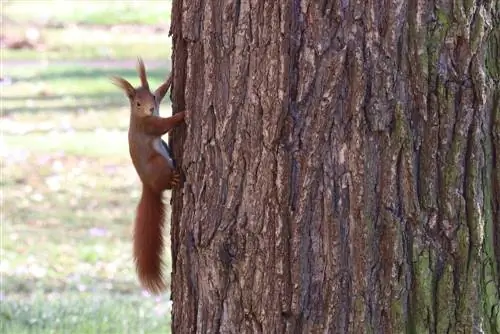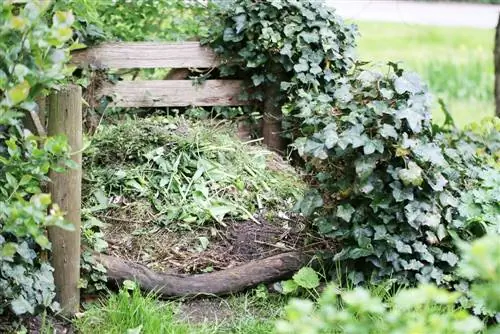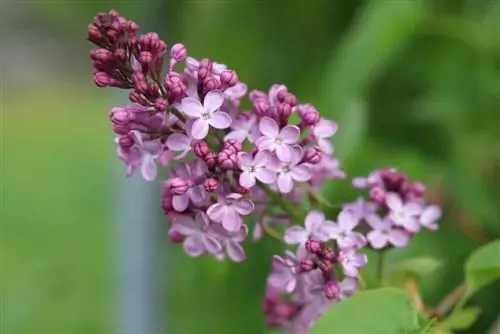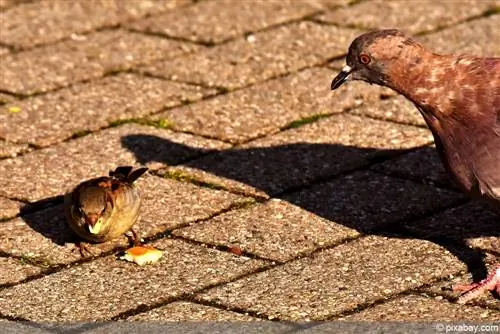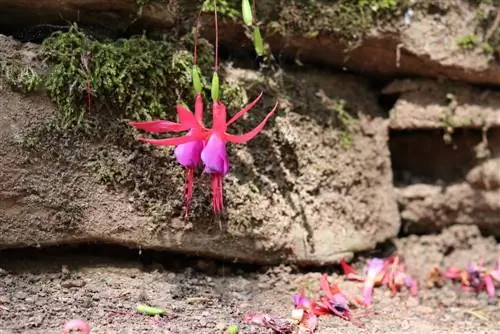- Author admin [email protected].
- Public 2023-12-17 03:39.
- Last modified 2025-06-01 06:48.
In winter, dangling suet balls and bulging feed silos are a familiar sight for birds. Squirrels usually go empty-handed when it comes to winter feeding. Contrary to popular belief, these cute rodents do not hibernate. If the cold season comes with severe frost, the agile climbing artists are threatened with starvation. This guide explains why this is the case and how to properly feed squirrels in winter.
Why is feeding squirrels useful?
Since extensive forest areas have become rare, every winter has been a challenge for squirrels. With foresight, the clever rodents build up numerous storage facilities in the fall in order to survive the barren winter period. Excessive forestry, overzealous gardeners and a harsh winter often thwart the cute squirrels' plans. Stockpiles are destroyed, buried under a thick layer of ice and snow, or can no longer be found. What makes matters worse is that the gestation period begins in January, which means lactating females have a high energy requirement. The sparse forest cover with monoculture trees further limits the food supply for hungry squirrels. This development makes human feeding a meaningful contribution to the preservation of this cute and endangered species.
Tip:
The time window for supplementary feeding for squirrels is open from autumn to summer. Only during the ripening period of local fruits and seeds can the little fur-bearers find everything their hearts desire in the wild.
The right winter food for squirrels
Animal lovers should take action and set up feeding stations when temperatures drop below freezing for several days at the latest. Special feed dispensers, feeders or boards that are attached to an elevated place in the tree are ideal. Here squirrels feel safe from attacks by sneaking predators. In case of danger, they can escape via the tree branches. If there are several squirrels in your garden, please create several feeding stations. Apart from the short mating season, the animals are solitary animals. A single source of food can then lead to wild chases and fierce fights with an uncertain outcome for the food rivals. You can collect suitable food yourself during a walk in the forest or buy it commercially. Your furry winter guests like to eat these fruits, nuts and seeds:
- Walnuts: are at the top of the popularity scale
- Hazelnuts: can be found in large quantities in the autumn forest
- Chestnuts, chestnuts: carefully examine purchased goods for mold
- Beechnuts
- Seeds from fir, pine and spruce trees: ideally the complete cones
- Sunflower seeds: the supermarket offers them cheaply
- Dried corn kernels
- Pine nuts and pine nuts: are in great demand and unfortunately quite expensive
- Berries: native species such as blueberries, blackberries, raspberries
- Raisins, sultanas
- Grapes
- Apple pieces
- Cut pears
- Carrot slices
- green cucumbers
- fresh mushrooms
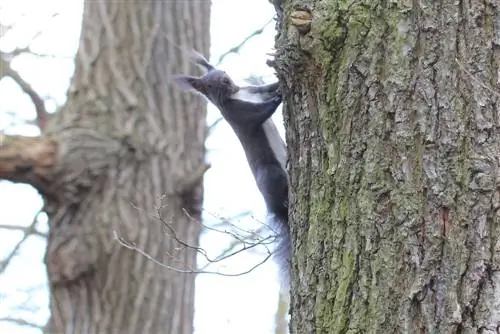
A balanced mix of soft fruits and vegetables as well as hard grains is the ideal supplementary food in winter. Because squirrels' nail teeth continually grow back, they need to be worn down on nuts, kernels and seeds. By the way, you don't have to crack the nuts into bite-sized pieces so that they fit into little squirrels' mouths. Scientific observations have shown that young animals can open sunflower seeds as early as 8 weeks old. The offspring learn how to crack thick nuts at the same time as the harvest season.
Tip:
Providing the right food for squirrels includes fresh water at any time of the year. Place small bowls near feeding areas and change the water daily. If there is a cold winter season without snow cover, such a watering hole can be life-saving for thirsty squirrels.
This food is taboo
Rotten, moldy food has no place in squirrel feeders and houses. Please check the food carefully before offering it to hungry rodents. If you wouldn't eat it yourself, it's not suitable for croissants. Store collected or purchased supplies indoors in a cool, dry and dark location.
Exotic fruits, nuts and seeds are frowned upon as food for squirrels. The following species and varieties are not on the menu:
- Almonds due to their toxic prussic acid content
- Peanuts are unhe althy and often affected by mold
- Green beans are not only indigestible for humans
Remove any food from the diet that squirrels cannot find in the wild. Apart from pine nuts and pine nuts, the small stomachs generally cannot tolerate fruits from distant countries. In addition, the food has to undergo a very long journey before it reaches the store shelf. The result is mold infestation, which is still invisible to the human eye in its early stages. For squirrels, consumption often has fatal consequences with little chance of survival.
Distance is vital - you should pay attention to this
In addition to the quality of the food, sufficient distance is very important if you want to feed wild squirrels properly. It is undoubtedly an exhilarating experience when tame squirrels accept food from your hand. Unfortunately, if the animals get too used to people, the vital instinct to flee is lost. This process makes the cute climbing artists easy prey for cats and other predators. Trustworthy squirrels also regularly become victims in traffic. Approach feeding areas primarily to replenish or check supplies.

